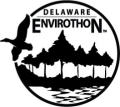Go to Aquatic Ecology Exercises and Sample Questions
Training Resources for Aquatic Ecology
Delaware is fortunate to have an abundance and variety of aquatic resources, including tidal and nontidal streams, ponds, marshes and other wetlands, and one of the busiest river/estuary systems in the country. These resources are vital to the lives and livelihood of Delawareans, and are in turn, affected by us in various ways. To better protect these resources for the future, we must first understand what they are, why they’re important, and how we impact them.
ENVIROTHON students will be able to:
- Identify the processes/phases of the water cycle: evaporation, transpiration, condensation, precipitation, surface runoff and percolation
- Analyze water supply issues, including the interaction of competing human uses for drinking, agriculture, industry, waste treatment, hydropower, navigation and recreation
- Collect and interpret data from basic water quality tests, including: dissolved oxygen, pH, alkalinity, nitrates, turbidity and temperature, and understand how these parameters can influence aquatic community composition
- Describe the effects of physical changes in water on the content of suspended gases (oxygen and carbon dioxide), and pH, and how this in turn impacts aquatic life
- Understand the difference between surface water and groundwater, and issues relating to the quality and quantity of each available for use in Delaware
- Contrast the locations, characteristics, and life forms typical of the following Delaware aquatic habitat types: Piedmont vs.Coastal Plain streams; tidal vs. nontidal marshes; Delmarva Bays vs. Inland Bays; Delaware River vs. Delaware Bay, and marine/estuarine/freshwater
- Given a description of a type of aquatic habitat (i.e. polluted/non-polluted), identify kinds of organisms most likely to live there. Identify common fishes, amphibians, benthic macro-invertebrates and aquatic plants found in Delaware
- Know what “anadromous” fish are, and the those that are important to Delaware’s fisheries
- Describe the life cycle, ecological significance and human uses of Delaware Bay horseshoe crabs
- Define what an Estuary is, and why it such a special and important part of our environment
- Understand the concept of a watershed, how to delineate them on topographic maps, and the water quality/land use connections to which they relate
- Distinguish between point and non-point source pollution, identify examples and sources of each, and describe strategies for their control
- Describe the characteristics, functions and values of wetlands, and how human activities relate to them
- Know the characteristics that distinguish a swamp from a marsh from a bog, and which of these and other wetland types are prominent in Delaware
- Understand the ecosystem concept as it applies to the aquatic realm and its important components (producers, consumers, decomposers, and plankton)
- Describe the process of biomagnification of pollutants, and be able to relate this to fish/ shellfish consumption bans and advisories
- Explain and give examples to show why we have regulations on the harvesting of fish and shellfish
- Identify the principal agencies,regulations, and laws responsible for protecting and managing our aquatic resources
- Locate two contrasting aquatic habitats to investigate (e.g. pool/riffle, pond/stream, tidal/non-tidal, upstream/downstream from pollution source, etc.). Using STREAM WATCH techniques*, gather water quality data and collect samples of macroinvertebrates from the two habitats. Identify the organisms and compare the diversity of life found in the two environments. Draw comparative conclusions from your data about the two habitats.
